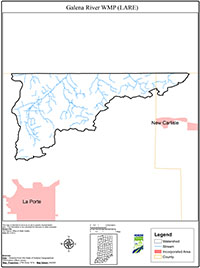Summary
Under a grant from the Indiana Department of Natural Resources (IDNR) Lake and River Enhancement Program (LARE), the LaPorte County Soil and Water Conservation District (SWCD) retained Baetis Environmental Services, Inc. to develop a diagnostic study and watershed management plan (WMP) for the Galena River watershed in northeast LaPorte County and northwest St. Joseph Counties, in north-central Indiana. The Galena River is part of the Little Calumet-Galien Watershed (Hydrologic Unit Code 04040001) which spans coastal areas of Illinois, Indiana, and Michigan. The headwaters of the Galena River are near Springfield Township in LaPorte County, approximately five miles north of LaPorte, Indiana and flow northeast through the northwest corner of St. Joseph County, Indiana and into Berrien County, Michigan.
The Galena River watershed is 112,222 acres. Around one-quarter of the watershed or approximately 29,684 acres lies in Indiana with the remainder in Berrien County, Michigan. This WMP covers only the Indiana portion of the watershed, where the drainage is the Galena River. A WMP covering the river as it flows through Berrien County, Michigan, where it is referred to as the Galien River, has been previously prepared by Fishbeck, Thompson, Carr, and Huber (2003). In Indiana, the Galena watershed remains relatively undeveloped; the two principal land uses are forest and agriculture. There are no large urbanized areas in the watershed. In comparison to other areas in the Little Calumet-Galien Watershed, the Galena River has not been significantly impacted by human influence. This is important to the watershed planning process; many of the recommendations involve conservation and preservation of existing environmental features, rather than remediation of already degraded environments.
In 2002, the Galena River was included on the Indiana Department of Environmental Management’s (IDEM)’s 303(d) list of impaired waters and has remained on this list through 2008. E. coli bacteria were identified as the cause of water use impairment. Surface waters that do not meet water quality standards, that is, do not support their designated uses; require development of a TMDL (Total Maximum Daily Load). In 2008, IDEM completed an extensive water quality study of the Galena River and its tributaries to measure E. coli, general chemistry, and nutrients to determine if the Galena River now supported its designated uses or a TMDL was indeed required. The results of that study confirmed that E. coli exceeded the water quality standards at eight of the nine sites selected for testing. Subsequently the IDEM prepared a draft TMDL for E. coli; IDEM is currently finalizing the TMDL report.
According to the IDEM water quality study, E. coli was the only parameter impairing water use and exceeded applicable water quality standards. Other chemical and nutrient parameters met standards, indicating that, with the exception of contact recreation, the stream’s designated uses were supported. Water quality results did not vary significantly, even during high flow events. In concert with the 2008 IDEM field studies, the IDNR and the LaPorte County SWCD completed habitat and biological assessments (October-November, 2008) at the same water quality sampling sites. Further information on the watershed was developed in 2009 and included a stream buffer analysis (by the IDNR) and a nonpoint source windshield survey of the watershed.
This planning effort included the formation of a Steering Committee, on which landowners, resource agency representatives, and non-governmental environmental organizations were invited to participate. The Steering Committee provided a forum for hearing stakeholder perspectives on current and desired watershed health; directed planning efforts to protect and restore water quality, including promoting implementation of the upcoming E. coli TMDL; generated goals and prioritizing projects for protecting and improving watershed quality; and assisted with field reconnoitering and identification of nonpoint pollution source areas. To be certain this plan could be eligible for future implementation funding, they submitted the final draft for review by a Watershed Specialist for approval that it meets the checklist required of 319 Nonpoint Source funded planning projects.

